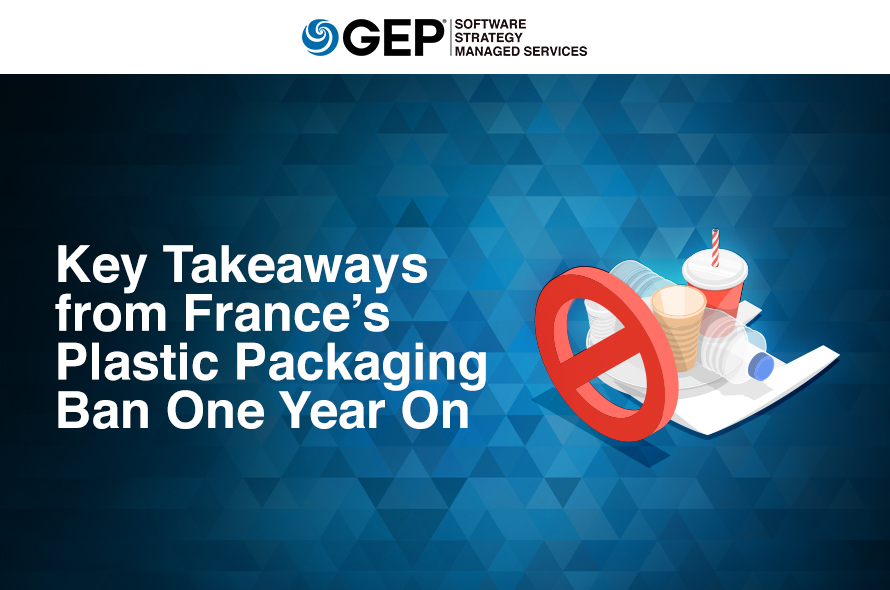Disclaimer
* Republished with permission. Originally published here by Manufacturing Outlook on December 1, 2022.
By Geoffroy Naegelen, Director, GEP, a leading provider of procurement and supply chain solutions to Fortune 500 companies.
Every major global consumer products manufacturer, from Unilever to Pepsi, have announced commitments to slash their use of plastic. As France is the first very large market requiring producers to switch from plastic to paper packaging, global manufacturers are watching closely to see how consumers respond, the cost of switching, and the impact to the market for paper-based and sustainable packaging. Companies including Danone, Coca-Cola, Nutella have started to implement more sustainable solutions, because they know if France is successful, plastic packaging bans will be adopted across the EU and beyond.
As part of its national 3R ― reduce, reuse, recycle ― strategy, France is focused on stopping all plastic bag single use for vegetables and fruits. Since January 1st, 2022, all non-transformed fruits and vegetables below 1.5 kg could not be wrapped with plastic, with some exceptions such as tomatoes, peaches, mushroom, and a variety of berries. With a €15.5 B market, French households consume 186 kg of fruits and vegetables per year and 40% of them are wrapped. These plastics single-serve packaging have proven to be a real disaster for the planet, prompting France’s initial legislation. France is now working to mobilize its European partners to adopt the same regulation.
THE INITIAL REPORT IS MIXED!
After almost one year of implementation of this law, what’s happened? What can CPGs, suppliers and packaging companies learn? How is the packaging sector evolving?
Well, first, according to association CLCV (Consommation, logement, Cadre de vie) recently completed study on plastic consumption, many vegetables and fruits still sell with single-serve plastic packaging. The lower than expected adherence to the new law is due in part because of a lack of preparation on the part of the manufacturers to adapt alternative packaging. Manufacturers successfully argued that the additional cost of switching to paper-based alternatives reduces competitiveness of French products. And a very powerful lobby successfully argued that removing plastic results in lower preservation of fruit and vegetables, and ultimately leads to greater waste.
But the French state and consumers are determined to make things happen and we’re already seeing the first benefits of this law, and industry wide changes.
First, there are large investments being made to develop alternative packaging solutions. For instance, Société Saint Andre Plastique, which gets 24% of its revenue using plastic wrapping, is increasing its R&D budget to develop biodegradable packaging. Cardboard suppliers are ramping up by adapting their tools and products for this new single-serve market. Recently the company Pack Alim announced it will double the size of its plant to design and produce this new packaging.
We’re also seeing the development of entirely new, sustainable packaging solutions. The future of packaging is very likely new plastic of plant origin! Alternative materials to plastic include the use of sugar cane fibers, wood pulp fibers, and other biodegradable materials. For example, a startup called Lactips. The startup develops, manufactures and markets water-soluble, biodegradable and bio-based plastic based on milk protein granules.
WHEN IT COMES TO PACKAGING, SIZE STILL MATTERS
The key for companies is how do you drive customer acceptance, because consumers are used to purchasing products in a certain way. For instance, cardboard-boxed water failed to take off, so far anyway. In the U.S., marketers tended to convey value through volume. The larger the package the greater the perceived value. We see this across most product categories, from detergents to soft drinks. However, the younger generation of consumers increasingly accept brands, and their packaging to be sustainable. Companies are responding, as evidenced by Nestle’s investment in developing biodegradable plastic bottles. Companies need to accelerate their research and efforts to determine what will be most appealing to their customers as the likely momentum for change heats up. Companies and consumers also need to examine packaging from a hygiene point of view. What we think of as ‘fresh’ will evolve along with the packaging.
REALIZING A FUTURE WITH LESS PLASTIC PACKAGING
Change to biodegradable alternative to plastics is coming, whether that’s driven by environment friendly legislation, environmentalists or consumers. We work with numerous global companies today that see environmentally-friendly packaging as an opportunity for innovation, sustainability, and differentiation. Some of the major categories we source and manage on a regular basis for our global companies include films and flexibles, sustainable plastic and glass containers, shrink and stretch wraps, polybags, metal and green packaging among others.
But the reality is that there is a massive amount to be done in research and innovation to evolve our economies and packaging to be much less dependent on plastic. The key to transitioning from plastic packaging is to focus on total cost reduction. Companies should understand every cost associated with what a change in packaging will mean to its organization’s financials, both globally and domestically. Costs should factor in short term issues such as cost per kilo/pound, as well as the impact new packaging could have on more or less shelf space for stocking purposes. This also includes the potential to pass along some new packaging costs directly to Millennials and Gen Z consumers who are more willing to pay a premium for products associated with sustainability.

